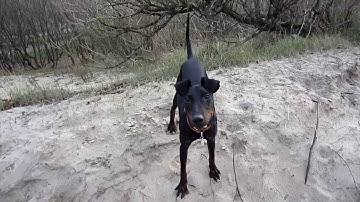
Manchester Terrier
Canis lupus familiaris

Meet the Manchester Terrier
The Manchester Terrier is a small, sleek, and agile dog breed originally developed in England for ratting and rabbit coursing. Recognized for its distinctive black-and-tan coat, wedge-shaped head, and keen, alert expression, this breed is both intelligent and spirited. Manchester Terriers are known for their loyalty and affectionate nature toward their families, while also displaying a lively and inquisitive temperament. Although compact, they are energetic and require regular exercise and mental stimulation. Their keen sense of smell and sight makes them excellent watchdogs.
Classification
Mammal
Habitat
Urban and suburban homes, often with access to yards or parks
Diet
Omnivore
Lifespan
14–16 years
Conservation
Least Concern
Weight
5–10 kg (11–22 lbs)
📖Fascinating Facts
Distinctive Appearance
Manchester Terriers are instantly recognizable by their glossy black-and-tan coat and elegant, streamlined build.
Ratting Heritage
Originally bred to hunt rats, these terriers were prized for their speed, agility, and determination in controlling vermin populations.
Adapted to City Life
The breed was popular among urban dwellers in Victorian England due to its manageable size and effectiveness as a household pest controller.
📋Detailed Description
The Manchester Terrier is a compact, well-balanced breed, typically standing 38–41 cm (15–16 in) at the shoulder and weighing between 5–10 kg (12–22 lbs), with males and females showing minimal sexual dimorphism. Its sleek, short, and dense coat is always jet black with rich mahogany tan markings, providing both camouflage in low-light environments and protection from the elements. The breed’s wedge-shaped head, keen dark eyes, and V-shaped, folded ears contribute to its alert and intelligent appearance. Anatomically, Manchester Terriers possess a deep chest, arched neck, and straight, muscular limbs, adaptations that enhance their agility and speed—traits essential for their historical role as ratters. Their tail is moderately short and tapers to a fine point, aiding in balance during rapid movement. The breed is known for its high energy, intelligence, and strong prey drive, making them both excellent working dogs and lively companions. Socially, Manchester Terriers form close bonds with their human families and can be reserved with strangers, often acting as vigilant watchdogs. They are generally healthy, with a lifespan of 14–16 years, though they may be predisposed to certain hereditary conditions such as von Willebrand’s disease and lens luxation. Their inquisitive and spirited temperament requires consistent mental stimulation and regular exercise to prevent boredom-related behaviors.
💡 Did you know?
The Manchester Terrier was one of the first breeds specifically developed for urban pest control in 19th-century England.
🔬Research & Sources
Wikipedia Summary
The Manchester Terrier is a breed of dog of the smooth-haired terrier type. It was first bred in the 19th century to control vermin, notably rats, at which it excelled. So efficient at the task was it that it often appeared in rat-baiting pits until that sport, which had effectively been illegal in the UK since 1835, finally died out at the beginning of the 20th century.
Last Modified: 2/26/2025
🎭Behavior & Social Structure
Manchester Terriers are highly active and intelligent, displaying pronounced terrier traits such as curiosity, independence, and a strong prey drive. Historically bred for vermin control, they retain a natural instinct to chase small animals and investigate scents, often engaging in digging or searching behaviors. They are quick learners, responding well to positive reinforcement training, but can be stubborn if not properly motivated. Socially, they are affectionate with their families, often forming strong attachments to one or two individuals, and may be wary or aloof with unfamiliar people or animals. Their daily routines typically include bursts of energetic play, exploratory walks, and periods of rest in close proximity to their owners. Manchester Terriers are known for their vocal tendencies, using barking to alert their families to perceived intruders or unusual occurrences. While generally tolerant of children and other dogs if socialized early, they may exhibit dominance or territorial behaviors, particularly toward smaller pets.
👶Reproduction & Life Cycle
Manchester Terriers reach sexual maturity between 8–12 months of age. The breed does not have a strict breeding season, as domestic dogs are capable of breeding year-round, but responsible breeders often plan litters in spring or early summer for optimal conditions. The estrous cycle in females lasts about 21 days, with a gestation period averaging 63 days (range: 58–68 days). Litters typically consist of 2–6 puppies. Maternal care is pronounced, with the dam providing warmth, grooming, and nursing for the first 3–4 weeks, after which puppies begin to wean and explore their environment. Socialization with humans and other animals during the early weeks is critical for behavioral development. Males do not participate in parental care. Breeding programs emphasize genetic screening to minimize hereditary health issues.
🛡️Adaptations & Survival
The Manchester Terrier’s physical adaptations include a streamlined body and long, slender limbs, allowing for rapid acceleration and agile maneuvering in pursuit of vermin. Their acute sense of smell and sharp eyesight are evolutionary specializations for detecting and tracking small prey in low-light urban or rural environments. The short, dense coat reduces the risk of entanglement and provides some resistance to dirt and moisture. Behaviorally, their intelligence and problem-solving abilities make them adept at navigating complex environments, while their high energy reserves support sustained activity. The breed’s alertness and vocal nature serve as effective deterrents against intruders, a trait that has been selectively reinforced through generations of breeding.
📚Research Sources
🎨Cultural Significance
The Manchester Terrier holds a unique place in British canine history, originating in the industrial city of Manchester during the 19th century. It was prized by working-class families and tradespeople for its efficiency in controlling rats and rabbits, contributing to public health and food security. The breed was a frequent participant in rat-baiting pits, a popular but now-outlawed sport, and its prowess in this arena contributed to its reputation for courage and agility. Over time, the Manchester Terrier became a fashionable companion for Victorian gentlemen, symbolizing both practicality and refinement. Today, it is celebrated for its historical significance and is occasionally featured in literature and art depicting Victorian England.
🔬Recent Research & Discoveries
Recent genetic studies have focused on the Manchester Terrier’s relationship to other terrier breeds, confirming its close genetic ties to the now-extinct Black and Tan Terrier and the Whippet, reflecting its dual heritage as both a ratter and a coursing dog. Ongoing research aims to map the breed’s genome to identify markers for hereditary diseases, particularly von Willebrand’s disease and lens luxation, to improve breeding outcomes. Behavioral studies have examined the breed’s high intelligence and trainability, finding that Manchester Terriers excel in canine sports such as agility, obedience, and scent work. Conservation efforts are underway in the UK and North America to maintain genetic diversity through international breeding collaborations.
🎥Wildlife Videos

How Baby Animals Survive in the Wild | HD Nature Documentary
The first months of a wild animal's life are full of challenges. From seal pups on stormy coastlines to bear cubs emerging from ...
Terra Mater

Wildlife - Just Wild Dogs | Free Documentary Nature
Wildlife - Episode 7: Just Wild Dogs | Wildlife Documentary Watch 'Wildlife - Episode 8' here: https://youtu.be/kglJpB4ei8o Run ...
Free Documentary - Nature

3 Hours of The Untold Stories of British Wildlife | Our World
A wildlife documentary series, narrated by Hugh Bonneville, uncovering the hidden lives of animals across diverse habitats ...
Our World

Manchester Terrier - AKC Dog Breed Series
Learn more about Manchester Terrier http://www.akc.org/dog-breeds/manchester-terrier/
American Kennel Club

Chester the Manchester Terrier and the blooming dunes
more on Chester: http://www.valta.nl/chester.html.
Chester & Valta

Chester the Manchester Terrier exploring the dunes of Wassenaar
My almost 7-month old Manchester Terrier 5 November 2011, near The Hague (The Netherlands) more on Chester: ...
Chester & Valta
🌍Habitat Information
The Manchester Terrier typically inhabits Urban and suburban homes, often with access to yards or parks environments. Manchester Terriers have adapted to their environments with specialized features and behaviors.
Primary Habitat:
Urban and suburban homes, often with access to yards or parks
More detailed habitat information will be available soon.
🛡️Conservation Status
The Manchester Terrier is currently classified as Least Concern. Conservation efforts are crucial for preserving this species for future generations.
Common Threats:
- 🏠Habitat loss and fragmentation
- 🌡️Climate change impacts
- 🎯Hunting and poaching
- 🏭Human-wildlife conflict
⚠️Threats & Conservation Challenges
While the Manchester Terrier is not considered at risk globally, the breed faces challenges related to declining popularity and a limited gene pool, particularly in the United Kingdom. This can increase the risk of hereditary diseases and reduce genetic diversity. Urbanization and changes in pest control practices have diminished their traditional working roles, leading to a reliance on responsible breeding and active pet ownership for their continued survival. Health concerns include predisposition to von Willebrand’s disease (a bleeding disorder), lens luxation, and hypothyroidism. Ethical breeding practices and health screening are essential to address these challenges. There are no significant wild or environmental threats, as the breed is fully domesticated.
🔬Scientific Classification
Scientific Name
Canis lupus familiaris
Classification Hierarchy
🔍 About Taxonomic Classification
Taxonomic classification is a hierarchical system used by scientists to classify and organize living organisms based on shared characteristics and evolutionary relationships.
The system moves from broad categories (Kingdom) to increasingly specific ones, with each animal's scientific name typically consisting of its Genus and species.
📝Community Notes
Share your observations and insights about the Manchester Terrier with our community of wildlife enthusiasts.
Join Our Community
Sign in to share your observations and connect with fellow wildlife enthusiasts.
Sign In to ContributeNo community notes yet
Be the first to share your observations about the Manchester Terrier!
Explore Manchester Terrier
Select a tab above to learn more about this amazing animal.
📸Photo Gallery
No photos available for this animal yet.
🌟Discover More Wildlife
Continue your journey of discovery with more fascinating animals from our database
